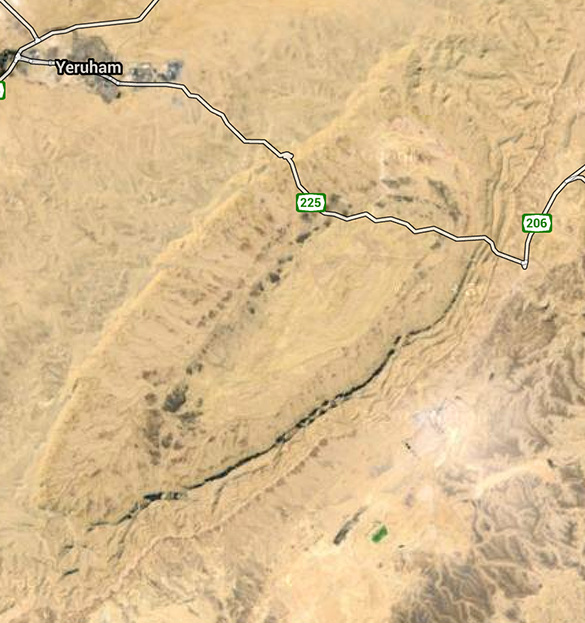 MITZPE RAMON, ISRAEL — Today I spent quality time with two Israeli students and some of the most interesting fossils in the world. Yael Leshno and Or Eliasson, students at Hebrew University, joined me for a walking journey through the Zohar and Matmor Formations (Middle Jurassic) in the northeastern part of Makhtesh Gadol. I’ve included a Google map above showing the makhtesh (an erosional crater in a breached anticline, to make it simple). The structure is about 10 km long, walled by Cretaceous sandstones with a soft, delightful core of Jurassic sediments. We worked today in a portion south of the main road through the makhtesh.
MITZPE RAMON, ISRAEL — Today I spent quality time with two Israeli students and some of the most interesting fossils in the world. Yael Leshno and Or Eliasson, students at Hebrew University, joined me for a walking journey through the Zohar and Matmor Formations (Middle Jurassic) in the northeastern part of Makhtesh Gadol. I’ve included a Google map above showing the makhtesh (an erosional crater in a breached anticline, to make it simple). The structure is about 10 km long, walled by Cretaceous sandstones with a soft, delightful core of Jurassic sediments. We worked today in a portion south of the main road through the makhtesh.
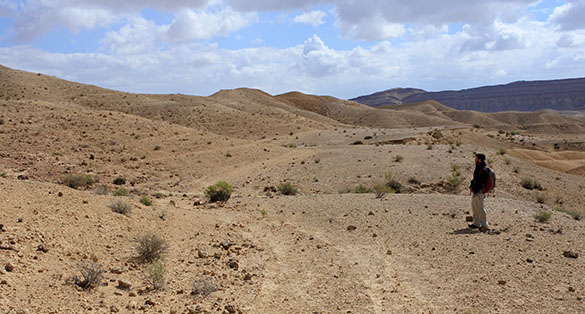 Or is standing here on the top of the basal unit of the Matmor Formation. We used this surface as a walkway to the brown hills in the background. Our first goal was to visit several outcrops of “Subunit 51”.
Or is standing here on the top of the basal unit of the Matmor Formation. We used this surface as a walkway to the brown hills in the background. Our first goal was to visit several outcrops of “Subunit 51”.
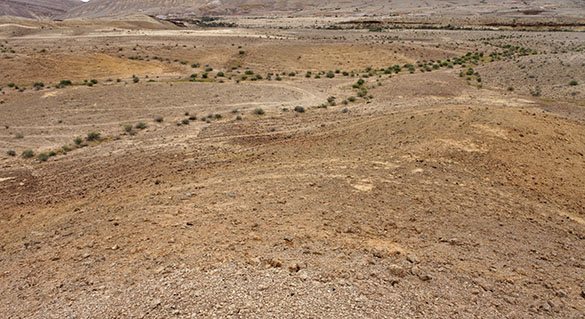 This unremarkable scene is actually the location of important and very well preserved Jurassic invertebrate fossils. The brown marls are the easternmost exposure of Subunit 51 of the Matmor Formation. They are loaded with corals, echinoids, crinoids, brachiopods, bryozoans (yes!), and other treasures. The soft marl helped preserve the fossils from most of the ravages of diagenesis, and makes them easy to free from the matrix. Some of the fossils we found here will be future Fossils of the Week on this blog. I particularly enjoyed our work in this interval today because Yael and Or are such excellent field paleontologists. They put their young eyes to good use.
This unremarkable scene is actually the location of important and very well preserved Jurassic invertebrate fossils. The brown marls are the easternmost exposure of Subunit 51 of the Matmor Formation. They are loaded with corals, echinoids, crinoids, brachiopods, bryozoans (yes!), and other treasures. The soft marl helped preserve the fossils from most of the ravages of diagenesis, and makes them easy to free from the matrix. Some of the fossils we found here will be future Fossils of the Week on this blog. I particularly enjoyed our work in this interval today because Yael and Or are such excellent field paleontologists. They put their young eyes to good use.
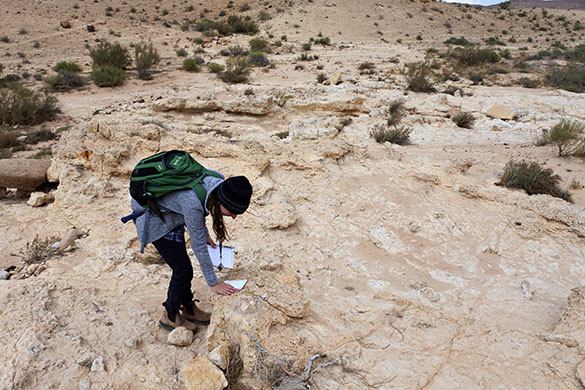 After lunch on the Matmor Formation, we walked south to find the lowest exposures of the Zohar Formation, which underlies the Matmor and “Kidod”. Here is the first outcrop we found, located in a wadi. Yael is doing here lithological and paleontological descriptions so that she can plan her next expedition to these rocks for her dissertation work.
After lunch on the Matmor Formation, we walked south to find the lowest exposures of the Zohar Formation, which underlies the Matmor and “Kidod”. Here is the first outcrop we found, located in a wadi. Yael is doing here lithological and paleontological descriptions so that she can plan her next expedition to these rocks for her dissertation work.
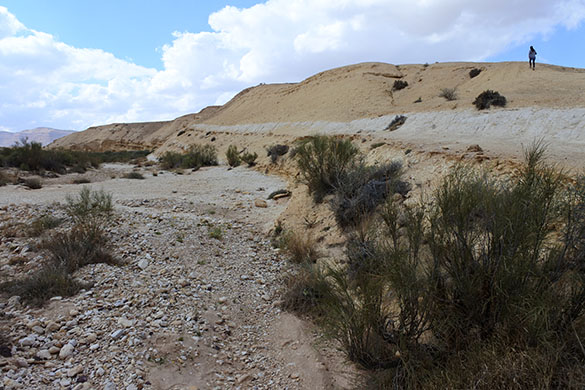 The lowest Zohar Formation in the makhtesh is exposed along a central wadi. Yael is on the skyline scouting it out. The upper beds where she is walking are very rich in mollusks, brachiopods, and echinoderms.
The lowest Zohar Formation in the makhtesh is exposed along a central wadi. Yael is on the skyline scouting it out. The upper beds where she is walking are very rich in mollusks, brachiopods, and echinoderms.
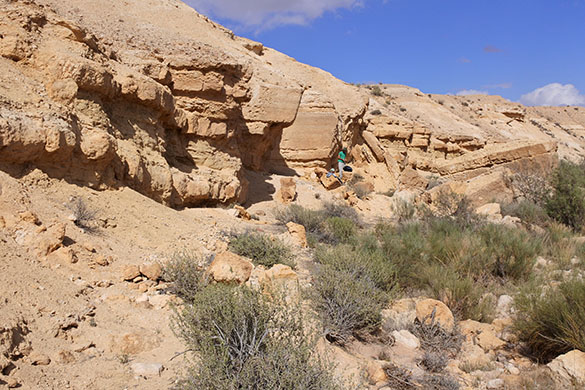 The Zohar Formation contains alternating limestones and marls, much like the Matmor.
The Zohar Formation contains alternating limestones and marls, much like the Matmor.
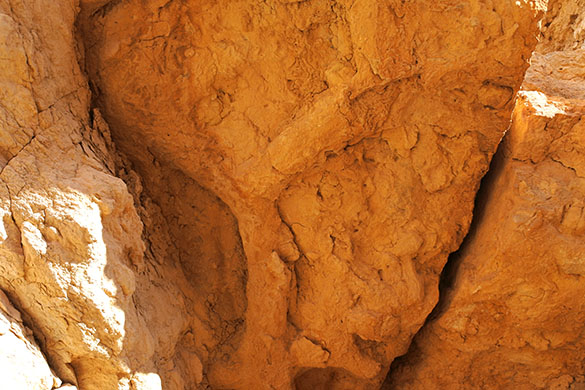 This is the underside of a thick layer of Zohar Formation limestone. It has convex hyporeliefs of Thalassinoides burrows about 5-10 cm in diameter. These were produced by burrowing crustaceans in shallow waters. The early geologists in this area did not recognize these features as trace fossils, referring to them as “negative mudcracks”.
This is the underside of a thick layer of Zohar Formation limestone. It has convex hyporeliefs of Thalassinoides burrows about 5-10 cm in diameter. These were produced by burrowing crustaceans in shallow waters. The early geologists in this area did not recognize these features as trace fossils, referring to them as “negative mudcracks”.
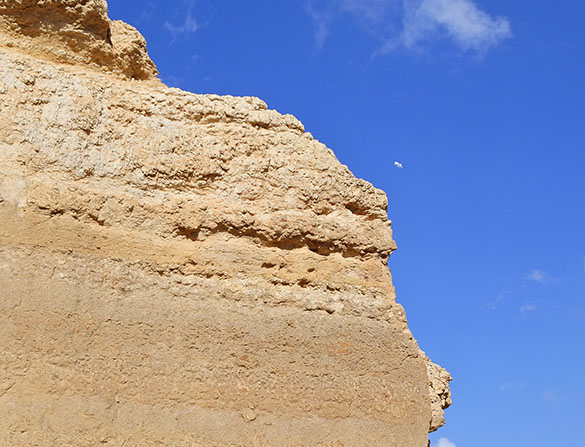 In this perspective on the Zohar limestones, you can just make out a white balloon in the far distant sky. This tethered balloon is operated by the Israel Defense Forces to watch over the border with Jordan with all kinds of fancy detection equipment (I imagine).
In this perspective on the Zohar limestones, you can just make out a white balloon in the far distant sky. This tethered balloon is operated by the Israel Defense Forces to watch over the border with Jordan with all kinds of fancy detection equipment (I imagine).
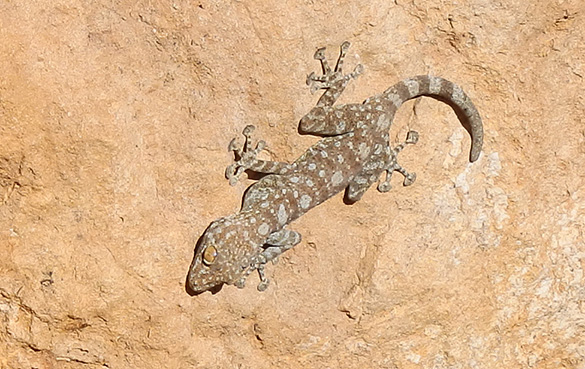 This little gecko watched us work at the Zohar outcrop.
This little gecko watched us work at the Zohar outcrop.
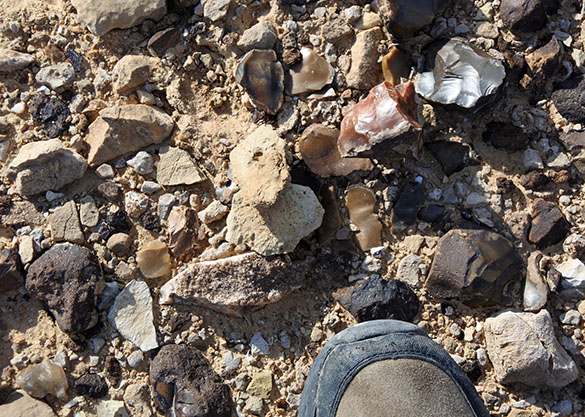 On our walk back to the car, sharp-eyed Or pointed out numerous flint flakes in a patch of desert pavement several meters square. These are the remains of a tool-making workshop. These are Mousterian and, astonishingly, about 150,000 years old. They were worked by Neanderthals!
On our walk back to the car, sharp-eyed Or pointed out numerous flint flakes in a patch of desert pavement several meters square. These are the remains of a tool-making workshop. These are Mousterian and, astonishingly, about 150,000 years old. They were worked by Neanderthals!
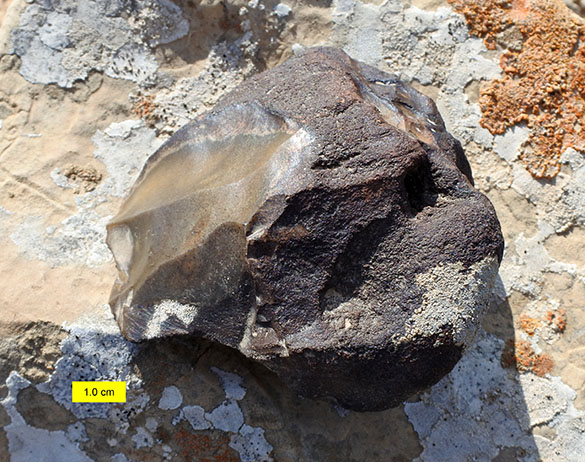 This is a lithic core, from which flakes were chipped by our busy cousins. I’ve seen this flint material all over the Negev, but hadn’t realized how old it is and who was responsible. I am very much in the Old World here.
This is a lithic core, from which flakes were chipped by our busy cousins. I’ve seen this flint material all over the Negev, but hadn’t realized how old it is and who was responsible. I am very much in the Old World here.


